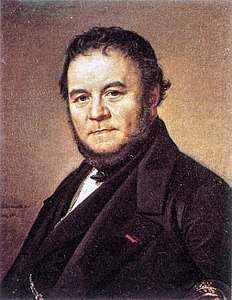Stendhal syndrome
Stendhal syndrome, Stendhal's syndrome or Florence syndrome is a psychosomatic condition involving rapid heartbeat, fainting, confusion and even hallucinations,[1] allegedly occurring when individuals become exposed to objects or phenomena of great beauty.[2]
History

The affliction is named after the 19th-century French author Stendhal (pseudonym of Marie-Henri Beyle), who described his experience with the phenomenon during his 1817 visit to Florence in his book Naples and Florence: A Journey from Milan to Reggio. When he visited the Basilica of Santa Croce, where Niccolò Machiavelli, Michelangelo and Galileo Galilei are buried, he was overcome with profound emotion. Stendhal wrote:
I was in a sort of ecstasy, from the idea of being in Florence, close to the great men whose tombs I had seen. Absorbed in the contemplation of sublime beauty ... I reached the point where one encounters celestial sensations ... Everything spoke so vividly to my soul. Ah, if I could only forget. I had palpitations of the heart, what in Berlin they call 'nerves'. Life was drained from me. I walked with the fear of falling.[3]
Although psychologists have long debated whether Stendhal syndrome exists, the apparent effects on some individuals are severe enough to warrant medical attention.[4] The staff at Florence's Santa Maria Nuova hospital are accustomed to tourists suffering from dizzy spells or disorientation after viewing the statue of David, the artworks of the Uffizi Gallery, and other historic relics of the Tuscan city.[1]
Though there are numerous accounts of people fainting while taking in Florentine art, dating from the early 19th century, the syndrome was only named in 1979, when it was described by Italian psychiatrist Graziella Magherini, who observed over a hundred similar cases among tourists in Florence. There exists no scientific evidence to define Stendhal syndrome as a specific psychiatric disorder; however, there is evidence that the same cerebral areas involved in emotional responses are activated during exposure to art.[5] The syndrome is not listed as a recognised condition in the Diagnostic and Statistical Manual of Mental Disorders.
A more recent account of the Stendhal syndrome was in 2018, where a visitor to the Uffizi Gallery in Florence suffered a heart attack while admiring Sandro Botticelli's The Birth of Venus.[6]
See also
- Double Rainbow
- Jerusalem syndrome
- Lisztomania
- Paris syndrome
- The Stendhal Syndrome, a psychological thriller film on the subject
References
- Nick Squires (28 July 2010). "Scientists investigate Stendhal Syndrome – fainting caused by great art". The Daily Telegraph. London. Retrieved 1 October 2019.
- Nicholson, Timothy Richard Joseph; Pariante, Carmine; McLoughlin, Declan (2009). "Stendhal syndrome: A case of cultural overload". BMJ Case Reports. 2009: bcr0620080317. doi:10.1136/bcr.06.2008.0317. PMC 3027955. PMID 21686859.
- Chatzichristodoulou, Maria; Jefferies, Janis; Zerihan, Rachel, eds. (2009). Interfaces of Performance. Ashgate Publishing, Ltd. p. 196. ISBN 9781409486145.
- Clyde Haberman (15 May 1989). "Florence's Art Makes Some Go to Pieces". The New York Times. Retrieved 1 October 2019.
- Innocenti, Claudia; Fioravanti, Giulia; Spiti, Raffaello; Faravelli, Carlo (1 March 2014). "La sindrome di Stendhal fra psicoanalisi e neuroscienze" [The Stendhal syndrome between psychoanalysis and neuroscience]. Rivista di Psichiatria (in Italian). 49 (2): 61–66. doi:10.1708/1461.16139. ISSN 2038-2502. PMID 24770571.
- Jones, Jonathan (18 December 2018). "Stendhal syndrome: can art really be so beautiful it makes you ill?". The Guardian. Retrieved 27 November 2019.
External links
- Word Spy definition
- Graziella Magherini. La Sindrome di Stendhal. Firenze, Ponte Alle Grazie, 1989. (in Italian)